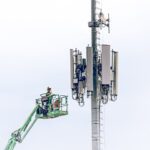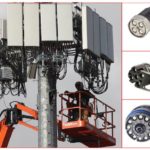Disruptive Innovations Impact Electronic Interconnects
Change has been an integral part of human experience since the beginning. What is new is the incredible rate and volume of change that is impacting the entire electronics industry. What disruptive innovations will impact your world?
 Over much of its existence, the electronic connector industry has been able to support new interconnect requirements through a series of incremental improvements of existing interfaces. Connectors have become smaller, easier to terminate, and capable of operating at higher speed and current rates, while offering much more design flexibility. As applications have become more demanding, connector manufacturers have increased their technical support resources to provide detailed CAD drawings, test and application specifications, 3-D models, recommended PCB footprint patterns, test boards, S-parameters, as well as direct engineering consultation to ensure performance.
Over much of its existence, the electronic connector industry has been able to support new interconnect requirements through a series of incremental improvements of existing interfaces. Connectors have become smaller, easier to terminate, and capable of operating at higher speed and current rates, while offering much more design flexibility. As applications have become more demanding, connector manufacturers have increased their technical support resources to provide detailed CAD drawings, test and application specifications, 3-D models, recommended PCB footprint patterns, test boards, S-parameters, as well as direct engineering consultation to ensure performance.
Innovative Devices
A universe of innovative devices driven by ever more powerful chip technology is inspiring the creation of entirely new market segments. Mobile devices, ranging from laptop computers to smart phones, have become an essential tool for billions of people around the world. The Internet of Things will bring billions more new devices online and will take advantage of 5G cellular, Bluetooth LE, ZigBee, and next generation Ethernet wireless technologies. Many of these devices will connect to the cloud, requiring constant upgrades of cloud infrastructure. The connector content of semi- and fully autonomous vehicles will likely be double that of conventional cars. Robotic devices of all types, from heavy industrial to personal companions, are a rapidly growing segment that will require multiple types of separable connectors. These emerging product markets represent huge business opportunities for suppliers who have invested in the resources capable of delivering connectors that will satisfy their unique requirements. The next five years are expected to be some of the most productive and potentially disruptive periods in our industry’s history.
Change is Coming in the Connector Industry
Just about every aspect of the connector industry is poised to change. The explosion of mobile products has begun to cut into sales of conventional copper I/O connectors as wireless links eliminate them. Mobile devices continue to shrink in size and weight, requiring designers to rethink every component, including connectors. Connections inside the box have been reduced to simple flex-film jumpers or stacking connectors. Elimination of the iPhone 7 audio jack illustrates the trend towards thinner devices that have no space for a connector. Eliminating the connector simplifies the challenge to make the product waterproof, an important feature in consumer products. Using a single, low-profile connector to provide multiple functions appears to be the wave of the future.
Connector manufacturers are also seeing a shift in their traditional base of original equipment manufacturers (OEMs). Some large consumers of connectors, such as Apple Computer, Ford Motor, and Raytheon, continue to thrive; others who have not adapted to this new environment have declined. Non-traditional manufacturers are now introducing new technology-based products. Amazon, the company that changed the world of e-commerce, also sells the Kindle e-reader and Echo personal digital assistant. Google, known for its search engine, has introduced a series of smart phones, wireless routers, and artificial reality headsets while experimenting with autonomous cars. Facebook has been a driving force behind the Open Compute Project, which is defining the design of optimized servers. Design engineers at these companies may have little experience with or allegiance to a specific connector supplier, making them receptive to whatever component source satisfies their needs. Identifying, building relationships, and influencing key individuals at these new hardware manufacturers are critical to achieving print position.
The rate by which new products are being developed is accelerating. The traditional design cycle involved basic concept definition, feasibility studies, prototype build and test, computer simulation, design verification, and final commitment to production. That cycle is being augmented with a more aggressive “fail-fast and retry” directive. New capabilities, such as rapid 3-D printing of prototypes, support this philosophy, and could result in reducing the need for technical support from connector manufacturers.
Challenges to Conventional Interconnect Technology
Some anticipated products, such as wearable electronics, may pose application challenges that cannot be satisfied with conventional interconnect technology. Research in exotic materials that range from graphene to woven conductive fibers may require development of entirely new connector technology. Years ago, leading connector manufacturers maintained in-house basic research laboratories that allowed them to identify the characteristics of reliable interconnects. The principals of contact physics and materials research proved invaluable as connectors became more sophisticated. To a large degree, these resources have been eliminated or outsourced, potentially limiting suppliers’ ability to address applications from a new perspective.
Sales volume and profitability have been volatile. In 2015, the entire connector industry suffered a 6% decline in business over the prior year. 2016 is shaping up to be a much better year, but spotty. Each of the 13 market segments and five regions of the world we track perform at different rates. Year-to-date bookings in Japan are down nearly 20%, while sales in the computer segment are down over 16%. Bishop & Associates is forecasting global 2016 connector sales at $52.8 billion, a 1.5% increase over 2015.
Finally, connector sales continue to migrate to Asia, causing connector manufacturers to move resources to follow. Originally, the objective was to take advantage of much lower labor costs, but we are now seeing marketing, sales, and even engineering departments relocating to better locally support the fastest-growing consumer markets.
Connector manufacturers have responded in a number of different ways. The industry continues to consolidate, with FCI Electronics joining the Amphenol camp in the most recent major acquisition. TE Connectivity, traditionally a very broad product range manufacturer, has sharpened its product mix on ruggedized connectors and sensors. It recently shed many of its standard fiber optic connector lines to concentrate on expanded beam technology used in industrial and mil/aero applications. Molex has recognized demand for higher density and speed I/O connectors and beefed up its already extensive product offerings in that segment. Samtec is expanding from its historic focus on high-speed mezzanine connectors with new offerings in high-speed optical and backplane interconnects.
Change has been an integral part of human experience since the beginning. The Greek philosopher Heraclitus said, 2,500 years ago, “There is nothing permanent except change.” What is new is the incredible rate and volume of change that is impacting the entire electronics industry.
Bishop & Associates has just released a market research report titled “Impact of Disruptive Innovations on Electronic Interconnects,” which outlines the current status of copper, fiber optic, and wireless interconnects and identifies 10 disruptive technologies that will likely have a major impact on each of them. For more detailed information about report #M-760-16, along with the table of contents, click here.
Recently published:
[related_posts limit=”10″]
- Optics Outpace Copper at OFC 2024 - April 16, 2024
- Digital Lighting Enhances your Theatrical Experience - March 5, 2024
- DesignCon 2024 in Review - February 13, 2024








